
Iran / MC. Aprilia 650 Pegaso
3.9 - 26.10.2003
Short Report B.v.H.H.S.
On an overcast and chilly day, early in the morning on September the 3rd 2003. the director, Nullo Facchini and I set off on our motorcycles in a southerly direction towards Rødby /Denmark and continued from Puttgarden towards Hamburg/Germany. The speed, the wind, the packed MC and the noise in our helmets reminded us that we were on our way. In Hamburg, we got on a train that carried cars and MC to Verona in northern Italy.
We spent that night in the company of other bikers who, like ourselves, had taken the opportunity of avoiding the boring, monotonous and crowded motorways that run through Europe. Having only just become the owner of a MC, it was an odd feeling finding yourself in an unfamiliar milieu in which the size and the type of your MC and outfit indicate who you are, why you drive a motorbike and subsequently to which subgroup you belong.
The Aim of the Journey
We were on our way to the Middle East on a two months journey of 12.000 km. It was a kind of pilgrimage arranged in connection with Seven Princesses, which was the name of the next site specific performance planned by Theater Cantabile 2 to take place in 2004. All the actors involved, scenographer, director and playwright must go on a kind of pilgrimage to some of the continents which, according to the book Haft Paykar, are the homelands of the Seven Princesses in the story. This book was written in verse by the Persian author, Nizami Ganjavi, at the end of the 12th century. Haft Paykar is one of the masterpieces of Persian literature., and it is as famous in the East as the Decameron.

Nizami Ganjavi's tomb / Ganca / Aserbajdsjan

Nizami Ganjavi's Statue / Baku / Aserbajdsjan
The final synopsis and the presentation of the performance show Seven Princesses are worked out partly on the basis of the adventures, which have been written down in the diaries by the participants, partly by means of visual images and the story of Haft Paykar.
How do we westerns and the Christians, relate to the interpret the Muslim world?
The next morning, having spent a night in which the sound of shrieking rails filled the air, we slipped into our outfits and jumped on our bikes. The sun was shining and the sky was limpid. I was filled with a fantastic feeling which was nevertheless slightly unreal: our dream journey had begun. But the speed , the wind and the noise called for control and concentration. The next stop was Trieste which borders on Slovenia. Having crossed Slovenia, Rumania, Bulgaria, Turkey, Georgia and Aserbajdsjan, we would finally reach the most eastern stop of the journeys, namely Teheran in Iran. On our way back, we would have to cross Turkey again, go through Greece and catch a boat to Ancona, Italy, and lastly we would go by train to Hamburg via Verona, and then travel the last bit to Copenhagen on the MC.
MC beginners
Due to the length of the journey, we had to cover 300-350 km. every day for four days, resting on the fifth. With this speed, we would physically be able to brush part of the culture of the Seven Princesses. Nullo had been planning the route for five months. Had taken his motorcycle driver’s licence and bought a Suzuki 650 Freewind from 1997, even before I learned about this extraordinary and wild motorcycle journey. ‘So Bjarne, wouldn’t you just love to go on a trip like that?’. Nullo asked me. And I certainly would ! I had been checking out bikes for five years, but I had never really found a good excuse for spending so much money on such an awkward means of transport designed for one person only. When I was young, I had a MC Nimbus which, unfortunately, I had to lose when I got married and had a child.
Having spent a week thinking it over, I agreed, seeing that I had to make ends meet both in terms of work and money. One month later, I had bought myself a Aprilia 650 Pegaso from 1997. In other words, a motorbike which weighed the same as Nullo’s, however, visually it ranked over his. They both belong to the Travel-Enduro model, which is tall, just like the Off Roader, but has a good suspension and considerably wider tyres, meaning that it runs smoothly on ordinary asphalt roads as well as on other kind of surface. In addition, the model in question is more comfortable when you go for at trip like the one we had in mind, a trip which more experienced bikers considered long and risky. And since I had only owned my bike for fifteen days, the two of us were completely inexperienced beginners having neither technical skills, nor the handiness to fix them, should they break down. However, the more experienced bikers both respected and envied us.
We had not been on the road for long when our lack of routine and experience became obvious. Going down the Italian autostrada at a speed of 140 km an hour. I noticed that the temperature of my bike had reached 120 degrees. It was sunny and about 30 degrees, an consequently, when I ran the engine at idle speed, its temperature would rise to 120 degrees. If, on the other hand I drove at a high speed, the wind would cool down the engine to a temperature about 80 degrees. But I reckoned that it could not be right, seeing that I had it checked at a garage before we left home. After a while I ran my bike in front of Nullo’s to signal to him that something was wrong. We pulled over and I noted that a liquid was leaking out of the bike. It had no smell, so it had to be anti-freeze. There was a small town 6 km ahead of us, and we decided to continue at a low speed, which turned out to be a mistake. A screw bolt in the cooling system pump had worked loose and fallen off. The entire engine had to be taken apart, the cylinder had to be twisted back in and the gaskets were changed. The reconditioning of the bike lasted six days and it cost me 1.500 $, but at least I learned a lesson: pull over if there is slightest sign that something is wrong, and do it before it is too late. Luckily the incident occurred only 60 km form Venice.
Now the Pilgrimage could Finally Begin
After this involuntary stay in Venice, where I, and thousand of other tourists, enjoyed the Biennal and the many beautiful buildings, I was on the road again. While Nullo had continued through Romania as planned. I had to go directly to Istanbul and meet up with him there. I drove across Slovenia to Zagreb in Croatia. From there I went on to Osiejk, a town in which the bullet holes and the bombed houses bore witness to the war. On the border to Yugoslavia, I found myself talking to a couple of very young Croatians (22 years old). When they were at war with the Serbians, they were moved to some camps for refugees at the age of fifteen, and they did not return to their home village until a few years ago. The friends they used to have, they no longer knew. They seemed quite rootless and filled with hatred towards the Serbians, even though some of them were once good friends and neighbours of theirs.


Zagreb/ Croatia



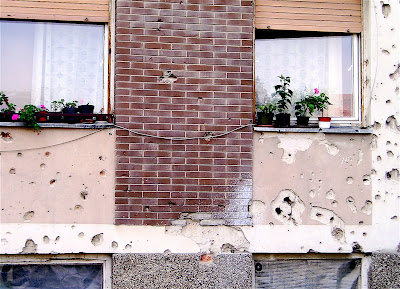
In Yugoslavia, just before the border to Bulgaria, I stopped to take some pictures of a beautiful little church situated in a desolate mountain scenery. As I was ready to continue, my bike would not start – trouble with the ignition! just as I had unbuckled my bags and was on may way to look for help, a very small and old car appeared. Behind the wheel was a priest wearing his vestments and around his neck hang a beautiful prayer chain. It was very old and had been given him as a mark of respect. His son , who was 19 years old and studied in Beograd to be a priest too, knew English. We drove around from one place to the other, it was getting late, and I have to find somebody who might help me fixing the bike.
While the father was trying to find someone who could help, I asked his son about the difference between Orthodox and plain Catholicism. In short, it turned out that people belonging to the former community believe the original interpretation of Catholicism to be the correct, and they also believe that a person cannot merely pay his way out of his sins.
As regards the recent war, he was deeply frustrated at the exiting hatred towards the Serbians, who are, after all, ordinary and decent human beings like the rest of us.
My MC. was retrieved and pulled up at the back of a truck. After a couple of hours of gesticulating, battery recharge and a few German words, I was on the road again. It was real dark, so I decided to go no longer than Pirot, at town situated just before Bulgarian border. Forty kilometres through a hundred tunnels on poor and winding roads ahead. So I was told by a truck driver I met in the café next to the garage when I told him where I was going and why.

You can click on the photo to be big


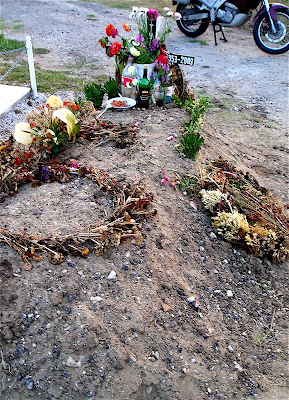

Serbia
Peace Pipe for Non-smokers
On my way there, I stopped at a gas station to refuel. The station attendant, who was sat outside eating his supper, offered me sardines and salad. Although I was quite hungry, my first reaction was to decline and hit the road. But, on the other hand, the aim of my pilgrimage was to get into contact with people of foreign cultures. I had to be more open. I took off my helmet and unzipped my jacket. However, being a vegetarian and s slightly stiff man of principles, I often have to decline what is generously offered me. Sometimes it feels as if I refuse to accept a peace pipe handed to me in a kind and solemn manner. In vain, you try to explain, with the help of gestures and unintelligible words, that you do not smoke, but that doesn’t mean that you don’t appreciate peace. Luckily, this time I could accept bread, cucumbers, tomatoes and salad, all the while enjoying the unexpected hospitality. Sometimes, the contrast has the effect of opening up a dialogue.
The following day, I crossed the border to Bulgaria and went through the country. Stopping to rest only three times on the way. But despite the rush, I got the chance to chat with a couple of Bulgarians. At my last stop, they asked me how I liked Bulgaria. The question remained unanswered. Half of my way through the country, I had spent on the motorways. I did pass some churches and villages which I would have liked to take a closer look at, but then again, either I keep my eye on the next destination, or I give up the original plan and continue by slow and winding roads. As a matter of fact, it reminds me at bit of the labour market.





 Istanbul / Turkey / The Blue Mosque
Istanbul / Turkey / The Blue Mosque
After dark, I crossed the Turkish border; an action which caused a great deal of trouble. I had entered a strange world in which the concept of time was of a different value and the people had a, to me unknown, way of communicating with their bodies and in their formulas.
Having driven around on the motorways just outside Istanbul for a long time finding no signs indicating where the centre was, I stopped at a gas station. In vain, I tried to make myself understood. Using my hands, I drew a circle with my left finger and thumb and pointed into the middle of the circle with my right index finger in order to explain the meaning of the word ’centre’. I did this several times, all the while repeating in a loud voice: ‘Istanbul – Centre!’
He made a violent and deprecating gesture, and said: ‘No, No! No sex!’ I found no gas station where I could buy a map of Istanbul or Turkey. Finally I found someone who understood that I was headed for the Blue Mosque, which I figured must be in the centre of Istanbul. But as it turns out, Istanbul has not just one but several centres.





Istanbul / Turkey
Istanbul / Turkey
The city has somewhere between eight and twenty million inhabitants, depending on what books you consult or what people you ask. The volume of traffic is amazing. Everybody pushes their way at a snail’s pace. No holds are barred when you want to make your way through the traffic, so you need to be alert. Riding a MC , you have a opportunity of twisting your way through, and so I did, along with a bunch of other MC. New York’s traffic is nothing compared to this. This kind of traffic suits my temperament. However, it is very fatiguing because I must keep in mind the extra width of my MC due to the panniers. The noise and the heat are insufferable, and you just go on and on. The signposts are almost non-existing, so you constantly have to guess where the winding road will take you.
In the evening, I was asked to dinner by two Turkish women who had invited Nullo to stay in their living room. They were members of the international organisation ‘Servas’, which mediates contact with people who know English well. These people will then explain to you all the ins and outs of their culture, and this will effect your conduct on the rest of the expedition. In addition, they had invited three other young friends of theirs with the purpose of recording some of the lullabies of their country. One of the women, who sang excellently, was accompanied by a friend of hers who played the guitar. The evening was sincerely warm and the music was beautiful.
Sedutive Turkish Rhythms
I succeeded in finding a ‘Servas’ host, a 26-year-old banker. The following evening, I joined him and his girlfriend at the annual party arranged by the chain of banks for all its employees. The party was given in an outdoor night club in the Asian half of Istanbul. The club was in the shape of a big ocean liner. From the deck you looked out over the water on the European half of the city. There were beautiful illuminated palaces, mosques and the great suspension bridge connecting, not just the two parts of the city, but also two continents.
The deck was crowded with festively dressed people who either danced or stood in groups around tables. But everybody was moving to the rhythm of the seductive Turkish pop tunes.
I was lucky to get together with some of the young people from the night before. Not so strange, considering that they too were employed in the earlier mentioned chain of banks.
One of the girls had an incredibly seductive way of moving her arms and body, which put you in mind of a seraglio’s dance of the veils. Having consumed a few glasses of red wine, my body too began making sliding a almost dreamlike movements. I felt my body move to the rhythm and merge into a soul to the tunes of this amazing Turkish music.

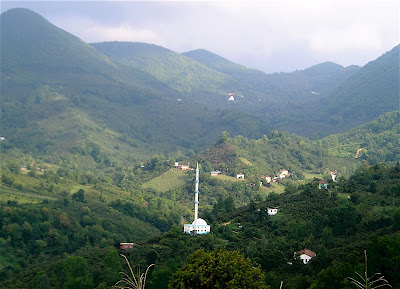
 Turkey
Turkey
Tbilisi / Georgia
Tbilisi / Georgia


MC. touble
The next day, we went to Sakarya and on to Safranbolu by the motorway. Then to Amasya and from there on to the Black Sea. We had a day of rest in Trabzon where we got our visa to Georgia and Aserbajdsjan. Afterward, we continued towards Artvin and crossed the border to Georgia.
The first 24 km in Georgia were awful because the road was very rough and full of holes and rocks. I figured that you would have to go with a fairly high speed, seeing that otherwise you might skid. The speed would make you go straight ahead without skidding.
This theory of mine might have proved correct if only you don’t carry as much luggage on your bike as I did. Going 30-40 km an hour. I stood up on my bike in an attempt to move the weight to the front, an action that resulted in the rear wheel skidding on some loose rocks. I could do nothing to prevent it from falling over, so the MC and I slipped to the right.
My panniers mitigated the force of the blow to a certain extent, but my foot got stuck under the MC and it hurt really bad. Fortunately, it was only a blow, and not a real sprain.
When the road was not full of small holes there were sparse gigantic ones measuring 10-30 cm in depth. In the guidebook Lonely Planet it said that the roads in Georgia have holes the size of Switzerland!
We had just left behind this hell of a stretch, as my bike and I tipped over again – twice in one day. I had taken the wrong road and turned around in a small village in the middle of a steep, upward gradient road covered with cobble stone. The rear wheel slid in a cow pat and my MNC turned over on the side. As I tried to lift it up, my foot slid in another cow pat.

Aserbajdsjan

Funeral




Art-Installation / Aserbajdsjan
Different rhythms
Having tried to keep pace with each other for at couple of days, we had to recognise that it probably would be better if we continued on our own. Our rhythms were so different. Nullo wanted to get quickly to the next destination before dark, so that he had time to explore the town and take pictures of the local people in their natural environment.
I, on the other hand, needed more breaks during the day in order to lose myself visually in the surroundings. I had a need to take my time to roll over on the grass, to enjoy the view or to feel the sea embrace my naked body. I needed the time to feel, using all my senses, the world which would otherwise just pass by, like a 3 D movie. I could really feel myself moving real fast both physically and mentally. I had to constantly adapt to new culture, new hotel rooms, food, currencies and germs . And in addition, I had to find my way and communicate on different levels in order to get a comprehensible answer.
It is the contrasts that I love. When you stop the engine, the silence overwhelms you, all the muscles in your body relax and you senses once again begin to co-operate. You let the world I, and you absorb it. But then when you mount your Pegasus again, step on it and feel how you rush forward towards new horizons, your body and the speed become one.
 A princesse in Baku / Aserbajdsjan
A princesse in Baku / Aserbajdsjan
Aserbajdsjan - There is always one that naturally leads the word, the natural leader. In this photo it is clear who's boss. I have an audience with the 'Godfather'. I was not allowed to take photos of his gold teeth. Instead I took the one that had gold around the mouth. Although women had also gold teeth.

Baku / Aserbajdsjan
The Pilgrimage
I took this trip very seriously, and considered it a true pilgrimage. It was not the historic monuments as much as the occasional, visual and emotional episodes that filled me with enthusiasm. Focusing on the individual was new to me. Travelling around the world in the past, I would always seek out the famous and sublime sights.
But on this trip my intention was to seek out the small village instead, and that was where I had the greatest thrills on my journey. The individual stands out and influences all your senses., unlike in the big cities, where cars, buildings, swarms of people and noise overshadow the individual. The people you meet in the villages are on their own stamping ground, and most of them have oceans of time and the energy to offer you a cup of tea.
They simply have the energy and the time to greet a stranger.
In this part of the world, you take your time. You are not committed to appointments of all sorts, the way we are. In the West, one wheel depends on the other, as in some kind of technological clockwork. You can’t just cancel, if you feel like it. We in the West have taken the rational and material highway. In this way, we come quickly to the fore and make a profit, but have no time to spend on anything else. You can’t just opt out when you please.
There are rules that must be obeyed if you want to play the game. In the East, you move forward by winding roads and purling streams, time for dreams, emotions and spiritual irrational thoughts.


Iran
Iran

Martyr Cementery / Rasht / Iran




DOWN WITH USA / Iran, near the border to Turkey


Rasht / Iran
Tabriz / Iran / This hotel is renowned for MC. are welcome in their lobby.
MC. soloist
An MC is a solo vehicle for the soloist, a solitary who will ride their own way at their own pace, which itself will set the agenda. A single dream for many, especially men, who dream of riding out there. Finding new horizons out of dreamland. Away from everyday obligations, a permanent job, spouse and children. MC represent the ultimate freedom, economic luxury. Its horsepower, can consume one place and country after another.
In countries like Turkey, Iran and Azerbaijan, where no young men can leave his country until he has done his military service. When they are finished with the service, they may have been married and therefore has no option because of the economy, to travel and see the world. This is why men, boys and young girls gather around you: you becomes a sort of catalyst for their dreams. They will hear, where you're going, how fast your MC is running, how much it costs, whether you have a wife and child, etc. You become a sort of messenger of news and dreams.
Ararat 5137 m./ Dogubayazit / Turkey


Dogubayazit / Turkey



Van Gölu / Turkey

 Cemetery 1200-1300 / Adilcevaz / Tyrkiet
Cemetery 1200-1300 / Adilcevaz / Tyrkiet
Seven Princesses
A friend of mine wrote in an email: ‘I hope that you’ll find your princesses on your way there!’, and I think I did. They met me, I met them, but merely as two strangers having neither the time nor the opportunity or the required vocabulary to get to know each other well enough. However, I did take pictures and ask for addresses of most of the people I met, thereby laying the groundwork for a more elaborate dialogue across countries and language barriers.
I recall the wonderful eight-years-old girl who came running towards me followed by her four-years-old sister. I had just packed my bike and, wearing my helmet along with the rest of my equipment, I was taking pictures of a tiny graveyard just outside Goreme, Turkey.
The entire family were about one hundred metres away. They were sat on a gigantic first floor terrace. They did not call har back. They let her speak to me. I took a picture of her and her sister. Then the family called me. I thought to myself: ‘Oh, what the hell!’, although I had almost reached that day’s destination where Nullo, as always, would be waiting for me.

 Nevsehir / Turkey
Nevsehir / Turkey
This was my chance to experience something new. The whole family was there on the terrace. In fact, this was the first time I greeted all the women one bye one nodding my head, and shook hands with all the males. One of the old men new German because he had once worked there for many years. While I was talking and consuming three cups of tea, I got the chance to shoot some ‘real’ family pictures. Only one of the women would let me videotape her. The little girls were radiantly happy running around with my camera showing everybody the photo I had taken of them. Seeing themselves portrayed like that was a hit. I also took a magnificent picture of the eight-years-old wearing my helmet. Her face shone with happiness as if she was some goddess from a strange planet.


In this report I have describe in short a few of the interesting human relations which have done their share towards making the trip the journey of my dreams.
Bjarne v.H.H.Solberg
Artist
&
Scenographer
BvHHS@email.DK
www.BvHHS.com
+45 30230036
Artist
&
Scenographer
BvHHS@email.DK
www.BvHHS.com
+45 30230036


Kozanh / Greece





Cemetery/ Greece

































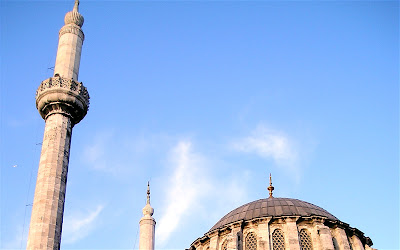

































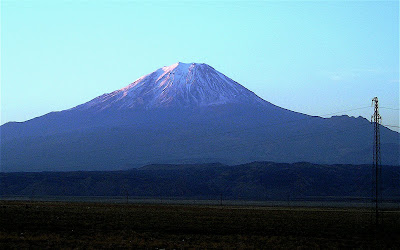










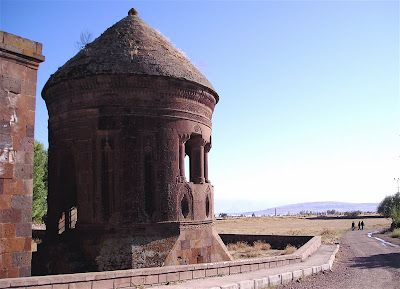















































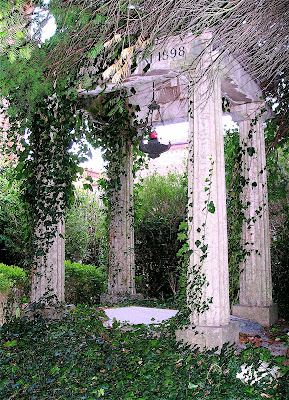






Ingen kommentarer:
Send en kommentar